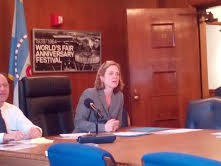
Queens Borough President Melinda Katz and the Borough Cabinet on Tuesday learned more about the new city default speed limit from DOT officials.
Photo by Alan Krawitz
Starting Nov. 7th, the default city speed limit—the speed limit when one is not posted—will drop to 25 mph from the current 30 mph, as part of the de Blasio administration’s Vision Zero initiative to make streets safer and reduce pedestrian accidents.
“Slower speeds save lives,” said Scott Johnson, project manager with the city Department of Transportation, during a presentation to the Borough Cabinet on roadway “slow zones” at Borough Hall on Tuesday.
Johnson, along with DOT Deputy Commissioner Nicole Garcia, explained to district managers from various community boards that the basic idea behind the slower-speed zones is to improve the safety of both motorists and pedestrians alike.
The two types of slow-zone programs currently being used by DOT are neighborhood slow zones, whereby community representatives can request the zones and select boundaries; while arterial, or “corridor” slow zones, are determined mainly by vehicle crash data and pedestrian injuries.
Johnson said that the zones typically employ digital speed boards, varied signal timing, posted signage/NYPD enforcement and speed bumps to slow down traffic.
Looking ahead to the future of the arterial slow zones, six zones in Queens are scheduled to be completed or approved by their respective communities and 27 in the city overall by the end of this year, according to the DOT.
Johnson added that the zones will be evaluated periodically for crash data, zone speeds and average travel times.
In Queens, arterial slow zones have already been implemented on Northern Blvd, from 40th Road to 114th Street; Jamaica Avenue from the Van Wyck Expressway to 224th Street; Queens Boulevard from Jackson Avenue/Northern Boulevard to Hillside Avenue; Rockaway Boulevard from 75th Street to Farmers Boulevard and Roosevelt Avenue from Queens Boulevard to 154th Street.
And this December, a slow zone is being planned for Metropolitan Avenue from Onderdonk Avenue to 132nd Street.
Gary Giordano, district manager of CB 5, asked whether emergency vehicles are affected by speed bumps and possibly prolonged response times inside slow zones. Johnson responded that the DOT takes into account routes used by emergency vehicles when planning slow zones.
Overall, Johnson reported that slow zones were helping to reduce crashes and injuries.
“So far, we have seen a 10 to 15 percent reduction in speeds, as well as a reduction in numbers of crashes with injuries and pedestrian injuries,” Johnson said.
He added that the program will continue in spring 2015, with every year having about seven or eight new slow zones implemented. “Community boards and civic groups can apply for zones in their area,” Johnson noted.
Frank Galluscio, district manager of CB 6, said that many civic groups in his area were unaware of the need to make an application to the DOT for a slow zone.
Borough President Melinda Katz asked specifically about how groups can make applications for the slow zones, noting that she was “more concerned” about arterial corridor slow zones rather than neighborhood streets.
“I assume you’re looking at these zones in terms of overall safety planning,” Katz addressed Johnson.
She added that her concern is that “good communication with the community boards and members of the community” regarding the zones will always be maintained.
Katz also asked both Garcia and Johnson if the DOT could appoint a liaison to work with the community boards on submitting applications and answering questions about slow zones.
Johnson, who noted that the application process was “very simple,” recommended that community board members with questions regarding slow zones and applications email the DOT directly.
By Alan Krawitz
